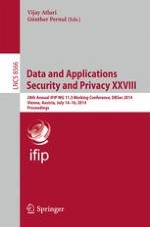2014 | Buch
Data and Applications Security and Privacy XXVIII
28th Annual IFIP WG 11.3 Working Conference, DBSec 2014, Vienna, Austria, July 14-16, 2014. Proceedings
herausgegeben von: Vijay Atluri, Günther Pernul
Verlag: Springer Berlin Heidelberg
Buchreihe : Lecture Notes in Computer Science
